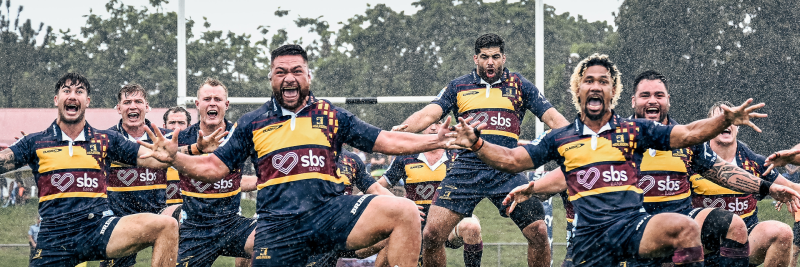Hautoa Kia Toa
A chant of engagement in battle for the Highlanders.
Composed by Waiariki Parata-Taiapa
(Kāi Tahu, Ngāti Porou, Ngāti Hine)

Kōrero Whakarāpopoto/Summary
Hautoa Kia Toa is a haka born from the whakapapa (genealogy), whenua (landscapes), moana (seas) and mita (dialect) of the Kāi Tahu, Kāti Mamoe and Waitaha whānau whānui (peoples) who are the kaitiaki (spiritual and physical guardians) of the mana (integrity) of where the Highlanders call home. This haka represents the strengths and intelligence of our Kāi Tahu peoples in battle and warfare. It draws a parallel to the Highlanders’ ethos and invites fearlessness, bravery and camaraderie in the heat of the battle. The haka is an expression of ihi, wehi and wana (our unique authenticity).
This haka was written by Waiariki Parata-Taiapa (Kāi Tahu, Ngāti Porou, Ngāti Hine) in collaboration with Mr Danny Poa (Ngāi Tūhoe, Ngāti Kahungunu) and Professor Anne-Marie Jackson (Ngāti Whātua, Ngāpuhi, Ngāti Kahu o Whangaroa) from the University of Otago, Te Koronga, School of Physical Education, Sport and Exercise Sciences and Ngā Pae o te Māramatanga.
In late 2020, Tony Brown (Kāi Tahu), Highlanders Coach (2014-17 and 2020-21), in conjunction with the Highlanders coaching and management staff and the 2021 co-captains Ash Dixon and Aaron Smith, initiated a conversation to create a new culture within the Highlanders built from authenticity of the unique location of the Highlanders in southern Aotearoa. Historically the Highlanders have a diverse range of players coming from many different places and backgrounds. The idea for creating a haka came from Tony Brown after returning from a Māori All Blacks campaign in 2020, where he was an Assistant Coach, as a way to bring their players, their Club and their community together for a new, shared purpose and identity.
Through Personal Development Manager Sonya O’Neill, building off the networks from her predecessor Mark Ranby, they approached Te Koronga staff, who had been working with the Highlanders for a few years in growing Te Reo Māori (Māori language), tikanga (protocols), te ao Māori (Māori worldview) and hauora (wellbeing) within the Club, to see the best way to create a haka, and to do it right. Through the long-standing relationship of Te Koronga with one of the Otago based hapū (sub-tribes), Kāti Huirapa ki Puketeraki, the scene was set for the creation of a haka. A discussion was initiated with Waiariki Parata-Taiapa (Kāi Tahu, Ngāti Porou and Ngāti Hine) who is a homegrown Kāi Tahu member who has served his whānau (family), hapū and iwi (tribe) in relation to Te Reo, tikanga and haka amongst many other talents.
Thus, the collaboration set about creating a haka that was authentically Kāi Tahu (one of the principal tribes of the Otago/Southland region) centric, built for the purpose of the Highlanders. For the team, the mana TonyBrown holds, being from Kāi Tahu, and his personal legacy in the Highlanders meant that the idea was appropriate. Also, the Highlanders co-captains at the time, Ash Dixon (Ngāti Tahinga) and Aaron Smith (Ngāti Kahungunu) were both leaders in their own right and in haka for the Māori All Blacks and the All Blacks respectively. Guidance was also provided from NZ Rugby’s Cultural Advisor Luke Crawford (Ngāti Porou, Ngāti Tūwharetoa).
A haka was created that intwines these shared aspirations and reflects Kāi Tahu histories and brings to light old stories. The actions, created with senior players and management, are powerful yet graceful, showcasing the mana of the Highlanders and reflecting the beauty of the landscapes of Te Waipounamu (South Island). The haka was performed publicly for the first time on the 22nd of February 2021 at Puketeraki Marae, which is one of the principal meeting houses of Kāi Tahu in the Southern region, and also of Waiariki. Here the Highlanders felt the mana of the people of Kāi Tahu in the courtyard of Tūmataueka (the God of War) to add meaning to their now shared legacy of the haka Hautoa Kia Toa. This represents a new collective journey for the Highlanders and for our community.
Tony Brown said at the time, “the haka is a unique representation of who we are, the region we belong to and play for. It’s something we have wanted to do for a while and we are delighted with the result. It has real meaning to the team and we were proud to perform it for the first time at home in front of our own people at the opening match of Sky Super Rugby Aotearoa 2021.”
Hautoa Kia Toa
Nā Waiariki Parata-Taiapa i tito
(Kāi Tahu, Ngāti Porou, Ngāti Hine)
| Whakaara taku pā | Uprise o’mighty fortress | |
| Whakaara taku haka | Awaken with my haka | |
| Hautoa te tū | Stand with confidence and courage | |
| Hautoa kia toa | Be brave as a warrior and we shall be victorious | |
| 5 | Whakawaha te riri | Let us engage in warfare |
| Ko tae rāia ki te umu kakara | We have arrived at the battle ground | |
| Kia whakatakotoria ai te mānuka | To lay down the challenge | |
| Ahakoa taku iti | Although we may be small in numbers | |
| He iti matā | We are a force to be reckoned with | |
| 10 | Hautoa kia toa | Be brave as a warrior and we shall be victorious |
| Aukaha kia kaha | Bind us firmly together as one | |
| Hautoa kia toa | Be brave as a warrior and we shall be victorious | |
| Aukaha kia kaha | Bind us firmly together as one | |
| Taku ihi, taku wehi, taku wana e | My essence, my uniqueness, my authenticity | |
| 15 | Hī! | Hī! |
Rārangi/Line
| 1-2 | Whakaara taku pā. The ancestor Tarewai uttered these words. He was a famous Kāi Tahu warrior from Ōtākou at Taiaroa Head on the Otago Peninsula. He was a giant of a man who was well known for wielding a large patu (handheld weapon). During a feud between Kāi Tahu and Kāti Mamoe, Tarewai was taken captive. He was sliced in half and his innards were exposed. He sewed (here) himself back up with resources such as the fat from a weka (a native bird) at the place called Hereweka (Harbour Cone). He made his way back to the feud and he saw his people were taken prison by Kāti Mamoe. Upon seeing this, he wanted to gain the attention of his people, and so he climbed a tree and using the reflection of the moon on his patu, he said “Whakaara taku pā, whakaara taku haka”. He encouraged his people to make an uproar and provide a distraction via the haka to initiate battle. Whilst this occurred, Tarewai made his way back into the feud and regained his dominance. |
| 5 | Whakawaha te riri. This is a saying from Kāti Kurī chief Tūteurutira who settled in Kaikōura and it refers to initiating a battle. Tūteurutira sought revenge upon the kidnapping of a wahine (woman) and he said “whakawaha te riri” “let us engage in warfare”. |
| 6 | Ko tae rāia. This is the Kāi Tahu dialect for kua tae rā anō. Umu kakara is a phrase from the ancestor Te Wera who established himself at Huriawa Pā, Karitāne, North Otago. He migrated further south, and upon his deathbed, he said to his children “kaua e mate pirau pēnei me au nei, me mate i ruka i te umu kakara, me haere i ruka i te umu kakara ki te tāpapa whawhai, ki tōku nei whakaaro, he mate rakatira tērā”, “do not die like me of old age, wasting away, die in the battlefield, in warfare, that’s a noble death”. |
| 7-8 | Ahakoa taku iti, he iti matā. The ancestor Rākaitauheke from Kāti Kurī said these words. He was known to be a very short man. Similar to phrase “ahakoa he iti, he pounamu”, “although it may be small, it is precious”. “Ahakoa taku iti, he iti matā” means “Although I am small, I am as sharp as the obsidian”. Matā refers to a type of obsidian, an important resource for the Kāi Tahu people. |
| 11 | Aukaha. This is a wider Kāi Tahu saying in relation to the process of binding and lashing ropes and was said to ensure unity. |
| 14 | Ihi, wehi and wana. These are personal characteristics that when expressed are also received. |



